Sugar Profile, Mineral Content, and Rheological and Thermal Properties of an Isomerized Sweet Potato Starch Syrup
- PMID: 26904593
- PMCID: PMC4745497
- DOI: 10.1155/2013/243412
Sugar Profile, Mineral Content, and Rheological and Thermal Properties of an Isomerized Sweet Potato Starch Syrup
Abstract
Currently, corn is used to produce more than 85% of the world's high fructose syrup (HFS). There is a search for alternative HFS substrates because of increased food demand and shrinking economies, especially in the developing world. The sweet potato is a feasible, alternative raw material. This study isomerized a high glucose sweet potato starch syrup (SPSS) and determined its sugar profile, mineral content, and rheological and thermal properties. Rheological and thermal properties were measured using a rheometer and DSC, respectively. Sweet potato starch was hydrolyzed to syrup with a mean fructose content of 7.6 ± 0.4%. The SPSS had significantly higher (P < 0.05) mineral content when compared to commercial ginger and pancake syrups. During 70 days of storage, the SPSS acted as a non-Newtonian, shear-thinning liquid in which the viscosity decreased as shear stress increased. Water loss temperature of the SPSS continually decreased during storage, while pancake and ginger syrups' peak water loss temperature decreased initially and then increased. Further and more detailed studies should be designed to further enhance the fructose content of the syrup and observe its stability beyond 70 days. The SPSS has the potential to be used in human food systems in space and on Earth.
Figures




References
-
- Dansby M. Y., Bovell-Benjamin A. C. Physical properties and sixth graders' acceptance of an extruded ready-to-eat sweetpotato breakfast cereal. Journal of Food Science. 2003;68(8):2607–2612. - PubMed
-
- Dansby M. A., Bovell-Benjamin A. C. Sensory characterization of a ready-to-eat sweetpotato breakfast cereal by descriptive analysis. Journal of Food Science. 2003;68(2):706–709. - PubMed
-
- Greene J. L., Bovell-Benjamin A. C. Macroscopic and sensory evaluation of bread supplemented with sweet-potato flour. Journal of Food Science. 2004;69(4):67–173.
-
- Hathorn C. S., Biswas M. A., Gichuhi P. N., Bovell-Benjamin A. C. Comparison of chemical, physical, micro-structural, and microbial properties of breads supplemented with sweetpotato flour and high-gluten dough enhancers. Food Science and Technology. 2008;41(5):803–815. doi: 10.1016/j.lwt.2007.06.020. - DOI
-
- Miller S. A. Optimization and evaluation of a hydroponic sweetpotato syrup [M.S. thesis] Tuskegee, Ala, USA: Tuskegee University Library; 2003.
LinkOut - more resources
Full Text Sources
Other Literature Sources

